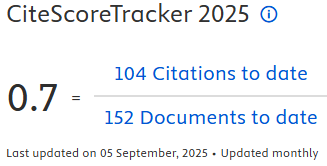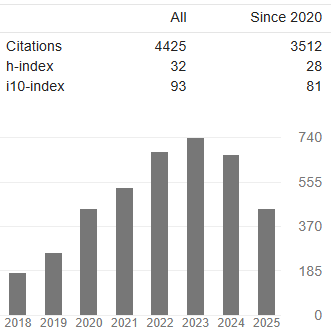PROFILING OF ANTHROPOMETRIC, BODY COMPOSITION, AND PHYSICAL FITNESS IN INDIVIDUALS WITH DISABILITIES USING THE MALAYSIA INSPIRE I-TALENT MANUAL

Downloads
Introduction: People with ID were reported prone to be overweight (22.5%) and obese (23.8%) compared to the general population and demonstrated poor level of physical fitness. Aims: This study aims to identify the anthropometric measurement and physical fitness profile in individuals with intellectual disability (ID) and examine the best factors that significantly contribute to explosive strength and balance performance. Method: 124 individuals with ID in Kelantan were recruited in this study. Anthropometry, body composition, and physical fitness were measured using Inspire i-Talent manual. Results: Individuals with ID in this study were overweight (24.27 kg/m2) and their fitness levels were considered generally poor. Stepwise regression analysis revealed that lower limb explosive power variable (R= 0.864, R2= 0.747, F= 34,947, p<0.05) can be anticipated from medicine ball throw, fat percentage and 505 agility test values. In addition, for upper body explosive power (R= 0.863, R2= 0.745, F= 4.223, p= 0.042) it can be forecasted from standing long jump, body weight, gender, static balance, and arm span. Lastly, standing long jump and 505 agility tests could be the main predictor of static balance (R= 0.597, R2= 0.356, F= 6,586, p= 0.011). Conclusion: Present finding can be used as a reference for researchers in Malaysia when prescribing and implementing physical assessment in ID population.
Andrews, B., Goosey-Tolfrey, V. and Bressan, E., 2009. The classification of sprinters with intellectual impairments: A preliminary analysis. South African Journal for Research in Sport, Physical Education and Recreation, 17. https://doi.org/10.4314/sajrs.v31i2.46319
Augustyn, N.J., 2005. The development of talent identification protocols for disability sport. Stellenbosch University.
Bartolomei, S., Grillone, G., Di Michele, R. and Cortesi, M., 2021. A comparison between male and female athletes in relative strength and power performances. Journal of Functional Morphology and Kinesiology, 6(1). https://doi.org/10.3390/jfmk6010017
Bartolomei, S., Rovai, C., Lanzoni, I.M. and di Michele, R., 2022. Relationships Between Muscle Architecture, Deadlift Performance, and Maximal Isometric Force Produced at the Midthigh and Midshin Pull in Resistance-Trained Individuals. Journal of Strength and Conditioning Research, 36(2), pp.299–303. https://doi.org/10.1519/JSC.0000000000003455
Barwick, R.B., Tillman, M.D., Stopka, C.B., Dipnarine, K., Delisle, A. and Sayedul Huq, M., 2012. Physical capacity and functional abilities improve in young adults with intellectual disabilities after functional training. Journal Of Strength and Conditioning Research, 26(6), 1638–43. https://doi.org/10.1519/JSC.0b013e318234e860
Bhaumik, S., Watson, J.M., Thorp, C.F., Tyrer, F. and McGrother, C.W., 2008. Body mass index in adults with intellectual disability: distribution, associations and service implications: a population-based prevalence study. Journal of Intellectual Disability Research, 52(4), 287–98. https://doi.org/10.1111/j.1365-2788.2007.01018.x
Borji, R., Zghal, F., Zarrouk, N., Sahli, S. and Rebai, H., 2014. Individuals with intellectual disability have lower voluntary muscle activation level. Research in Developmental Disabilities, 35(12), 3574–81. https://doi.org/10.1016/j.ridd.2014.08.038
Bouffard, M. and Wall, A.E., 1990. A Problem Solving Approach to Movement Skill Acquisition: Implications for Special Populations. 107–131. https://doi.org/10.1016/S0166-4115(08)61179-6
Bruhn, S., Kullmann, N. and Gollhofer, A., 2006. Combinatory effects of high-intensity-strength training and sensorimotor training on muscle strength. International Journal of Sports Medicine, 27(5), 401–6. https://doi.org/10.1055/s-2005-865750
Buchan, D.S., Young, J.D., Simpson, A.D., Thomas, N.E., Cooper, S.-M. and Baker, J.S., 2012. The effects of a novel high intensity exercise intervention on established markers of cardiovascular disease and health in Scottish adolescent youth. Journal of Public Health Research, 1(2),155–7. https://doi.org/10.4081/jphr.2012.e24
Burns, J., 2015. The impact of intellectual disabilities on elite sports performance. International Review of Sport and Exercise Psychology, 8(1), 251–267. https://doi.org/10.1080/1750984X.2015.1068830
Cabrejas, C., Solana-Tramunt, M., Morales, J., Campos-Rius, J., Ortegón, A., Nieto-Guisado, A. and Carballeira, E., 2022. The Effect of Eight-Week Functional Core Training on Core Stability in Young Rhythmic Gymnasts: A Randomized Clinical Trial. International Journal Of Environmental Research And Public Health, 19(6). https://doi.org/10.3390/ijerph19063509
Carmeli, E., Bar-Yossef, T., Ariav, C., Levy, R. and Liebermann, D.G., 2008. Perceptual-motor coordination in persons with mild intellectual disability. Disability and Rehabilitation, 30(5), 323–9. https://doi.org/10.1080/09638280701265398
Carter-Thuillier, B., Ramírez-Campillo, R., Serra-Olivares, J., Gallardo, F., Cresp, M., Ojeda Nahuelcura, R., Álvarez, C., Martínez, C. and Cañas-Jamett, R., 2019. Anthropometric Characteristics of Female and Male Athletes Bear A Different Effect on Fitness. Asian Journal of Sports Medicine, 10(2). https://doi.org/10.5812/asjsm.66164
Castro-Piñero, J., Ortega, F.B., Artero, E.G., Girela-Rejón, M.J., Mora, J., Sjöström, M. and Ruiz, J.R., 2010. Assessing muscular strength in youth: usefulness of standing long jump as a general index of muscular fitness. Journal of Strength And Conditioning Research, 24(7), 1810–7. https://doi.org/10.1519/JSC.0b013e3181ddb03d
Chow, B.C., Choi, P.H.N. and Huang, W.Y.J., 2018. Physical activity and physical fitness of adults with intellectual disabilities in group homes in Hong Kong. International Journal of Environmental Research and Public Health, 15(7). https://doi.org/10.3390/ijerph15071370.
Çimen Polat, S., 2018. Evaluation of some motoric parameters of pre-school gymnasts and their relations. Pedagogical Research, 3(3). https://doi.org/10.20897/pr/2664
Ćopić, N., Dopsaj, M., Ivanović, J., Nešić, G. and Jarić, S., 2014. Body composition and muscle strength predictors of jumping performance: differences between elite female volleyball competitors and nontrained individuals. Journal of Strength And Conditioning Research, 28(10), 2709–16. https://doi.org/10.1519/JSC.0000000000000468
Cowley, P.M., Ploutz-Snyder, L.L., Baynard, T., Heffernan, K., Jae, S.Y., Hsu, S., Lee, M., Pitetti, K.H., Reiman, M.P. and Fernhall, B., 2010. Physical fitness predicts functional tasks in individuals with Down syndrome. Medicine and Science in Sports and Exercise, 42(2), 388–93. https://doi.org/10.1249/MSS.0b013e3181b07e7a
Diker, G., Müniroğlu, S., Ön, S., Özkamçı, H. and Darendeli, A., 2021. The relationship between sprint performance and both lower and upper extremity explosive strength in young soccer players. Pedagogy of Physical Culture and Sports, 25(1), 10–14. https://doi.org/10.15561/26649837.2021.0102
Elsabet, B., 2022. Relationships among anthropometric characteristics, physical fitness qualities and sprinting performance: “the case of Ethiopian youth sport academy male sprinters.
Emerson, E. and Hatton, C., 2013. Health Inequalities and People with Intellectual Disabilities. Cambridge University Press. https://doi.org/10.1017/CBO9781139192484.
França, C., Gouveia, É.R., Coelho-e-Silva, M.J. and Gomes, B.B., 2022. A Kinematic Analysis of the Basketball Shot Performed with Different Ball Sizes. Applied Sciences, 12(13), 6471. https://doi.org/10.3390/app12136471
Hammami, R., Granacher, U., Pizzolato, F., Chaouachi, M., Chtara, M., Behm, D. and Chaouachi, A., 2017. Associations between Change of Direction, Balance, Speed, and Muscle Power in Prepubescent Soccer Players. Journal of Athletic Enhancement, 06. https://doi.org/10.4172/2324-9080.1000279.
Hilgenkamp, T.I.M., van Wijck, R. and Evenhuis, H.M., 2012. Low physical fitness levels in older adults with ID: results of the HA-ID study. Research In Developmental Disabilities, 33(4), 1048–58. https://doi.org/10.1016/j.ridd.2012.01.013
Hilgenkamp, T.I.M., van Wijck, R. and Evenhuis, H.M., 2013. Feasibility of eight physical fitness tests in 1,050 older adults with intellectual disability: results of the healthy ageing with intellectual disabilities study. Intellectual And Developmental Disabilities, 51(1), 33–47. https://doi.org/10.1352/1934-9556-51.01.033
Jeng, S.-C., Chang, C.-W., Liu, W.-Y., Hou, Y.-J. and Lin, Y.-H., 2017. Exercise training on skill-related physical fitness in adolescents with intellectual disability: A systematic review and meta-analysis. Disability and Health Journal, 10(2), 198–206. https://doi.org/10.1016/j.dhjo.2016.12.003
Jeong, G. and Chun, B., 2021. Analysis of the relationship between obesity factors and health-related physical fitness factors among people with intellectual disabilities in South Korea. International Journal of Environmental Research and Public Health, 18(12), 6533. https://doi.org/10.3390/ijerph18126533
Jeon, Y. and Eom, K., 2021. Role of physique and physical fitness in the balance of Korean national snowboard athletes. Journal of Exercise Science and Fitness, 19(1), 1–7. https://doi.org/10.1016/j.jesf.2020.07.001
Jones, P., Bampouras, T.M. and Marrin, K., 2009. An investigation into the physical determinants of change of direction speed. The Journal of Sports Medicine and Physical Fitness, 49(1), 97–104.
Jose Irineu Gorla, Paulo Ferreira de Araújo and Jose Luiz Rodrigues, 2003. Motor coordination of individuals with intellectual disability: evaluation and intervention.
Kirk, C., 2016. Does Stature or Wingspan Length Have a Positive Effect on Competitor Rankings or Attainment of World Title Bouts in International and Elite Mixed Martial Arts? Sport Science Review, 25(5–6), 334–349. https://doi.org/10.1515/ssr-2016-0018
Kloubec, J.A., 2010. Pilates for improvement of muscle endurance, flexibility, balance, and posture. Journal of Strength and Conditioning Research, 24(3), 661–7. https://doi.org/10.1519/JSC.0b013e3181c277a6
Krause, S., Ware, R., McPherson, L., Lennox, N. and O’Callaghan, M., 2016. Obesity in adolescents with intellectual disability: Prevalence and associated characteristics. Obesity Research & Clinical Practice, 10(5), 520–530. https://doi.org/10.1016/j.orcp.2015.10.006
Kriswanto, E.S., P.A.F., R.H., A.S., & P.H., 2021. Effect of leg length on running speed of sports and health sciences students in Indonesia: A meta-analysis study. Journal of Physical Education and Sport, 21(05).
Krystyna Gawlik and Zwierzchowska, A., 2004. Wychowanie fizyczne dzieci i młodzieży zniepełnosprawnością intelektualną.
Kutlay, E., Haslofça, F. and Haslofça, E., 2020. The relationship between anthropometric characteristics and physical fitness parameters of figure skating athletes. European Journal of Physical Education and Sport Cience, 6(7). https://doi.org/10.46827/ejpe.v6i7.3290
Kyriazis, T., Terzis, G., Karampatsos, G., Kavouras, S. and Georgiadis, G., 2010. Body composition and performance in shot put athletes at preseason and at competition. International Journal of Sports Physiology and Performance, 5(3), 417–21. https://doi.org/10.1123/ijspp.5.3.417
Lahtinen, U., Rintala, P. and Malin, A., 2007. Physical performance of individuals with intellectual disability: a 30 year follow up. Adapted Physical Activity Quarterly : APAQ, 24(2), 125–43. https://doi.org/10.1123/apaq.24.2.125
Lee, J.-Y. and Lee, D.-Y., 2018. Effect of different speeds and ground environment of squat exercises on lower limb muscle activation and balance ability. Technology and health care : official journal of the European Society for Engineering and Medicine, 26(4), 593–603. https://doi.org/10.3233/THC-181201
Lloyd, M., Temple, V.A. and Foley, J.T., 2012. International BMI comparison of children and youth with intellectual disabilities participating in Special Olympics. Research in Developmental Disabilities, 33(6), 1708–14. https://doi.org/10.1016/j.ridd.2012.04.014
Malina, R.M., Bouchard, C., and Bar-Or, O., 2004. Growth, maturation, and physical activity. Human kinetics. https://doi.org/10.5040/9781492596837
Meyers, R.W., Oliver, J.L., Hughes, M.G., Cronin, J.B. and Lloyd, R.S., 2015. Maximal sprint speed in boys of increasing maturity. Pediatric Exercise Science, 27(1), 85–94. https://doi.org/10.1123/pes.2013-0096
Michael J. Boyle, 2016. New functional training for Sports 2nd edition Ebook. 2nd ed. Human Kinetics. https://doi.org/10.5040/9781718225718
Mirzaei, B., Loti, N. and Saeidi, P., 2011. The relationship between anthropometric parameters, body composition and explosive power in cadet wrestlers.
Mohammadi, F., Rajabi, R., Alizadeh, M. and Bayattork, M., 2021. Physical fitness and body composition profile of young people with mild intellectual impairment: a cross-sectional study among Iranian population. hasesj, 1(1), 40–48. https://doi.org/10.52547/hases.1.1.40
Murbawani, E.A. and Gizi, B., 2017. Hubungan Persen Lemak Tubuh dan Aktivitas Fisik dengan Tingkat Kesegaran Jasmani Remaja Putri. Journal of Nutrition and Health, 5(2).
NICHCY, 2012. National dissemination center for children with disabilities
Norton, K. and Olds, T., 2001. Morphological evolution of athletes over the 20th century: causes and consequences. Sports medicine (Auckland, N.Z.), 31(11), 763–83. https://doi.org/10.2165/00007256-200131110-00001.
Oppewal, A., Hilgenkamp, T.I.M., van Wijck, R. and Evenhuis, H.M., 2013. Feasibility and outcomes of the Berg Balance Scale in older adults with intellectual disabilities. Research in Developmental Disabilities, 34(9), 2743–52. https://doi.org/10.1016/j.ridd.2013.05.040
Orssatto, L.B.R., Bezerra, E.S., Schoenfeld, B.J. and Diefenthaeler, F., 2020. Lean, fast and strong: Determinants of functional performance in the elderly. Clinical Biomechanics, 78, p.105073. https://doi.org/10.1016/j.clinbiomech.2020.105073.
Padulo, J., Migliaccio, G.M., Ardigò, L.P., Leban, B., Cosso, M. and Samozino, P., 2017. Lower limb force, velocity, power capabilities during leg press and squat movements. International Journal of Sports Medicine, 38(14), 1083–1089. https://doi.org/10.1055/s-0043-118341
Perry, M.C., Carville, S.F., Smith, I.C.H., Rutherford, O.M. and Newham, D.J., 2007. Strength, power output and symmetry of leg muscles: effect of age and history of falling. European Journal of Applied Physiology, 100(5), 553–61. https://doi.org/10.1007/s00421-006-0247-0
Slinde, F., Suber, C., Suber, L., Edwén, C.E. and Svantesson, U., 2008. Test-retest reliability of three different countermovement jumping tests. Journal of Strength and Conditioning Research, 22(2), 640–4. https://doi.org/10.1519/JSC.0b013e3181660475
Stewart, A., Marfell-Jones, M., Olds, T. and De Ridder, J., 2011. International
Standards for Anthropometric Assessment. Potchefstroom, South Africa, ISAK, .
Stork, S. and Sanders, S.W., 2008. Physical education in early childhood. The Elementary School Journal, 108(3), 197–206. https://doi.org/10.1086/529102
Sulton, K. and Jajat, J., 2019. Relationship between Gross Motor Skills and Body Mass Index of Children with Intellectual Disability. In: Proceedings of the 3rd International Conference on Sport Science, Health, and Physical Education (ICSSHPE 2018). Paris, France: Atlantis Press. https://doi.org/10.2991/icsshpe-18.2019.60
Westendorp, M., Houwen, S., Hartman, E. and Visscher, C., 2011. Are gross motor skills and sports participation related in children with intellectual disabilities? Research in Developmental Disabilities, 32(3), 1147–53. https://doi.org/10.1016/j.ridd.2011.01.009.
Winter, C.F., Bastiaanse, L.P., Hilgenkamp, T.I.M., Evenhuis, H.M. and Echteld, M.A., 2012. Cardiovascular risk factors (diabetes, hypertension, hypercholesterolemia and metabolic syndrome) in older people with intellectual disability: Results of the HA-ID study. Research in Developmental Disabilities, 33(6), 1722–1731. https://doi.org/10.1016/j.ridd.2012.04.010
Yang, S.-C., Lin, S.-J. and Tsai, C.-Y., 2015. Effect of sex, age, and BMI on the development of locomotor skills and object control skills among preschool children. Perceptual and motor skills, 121(3), 873–88. https://doi.org/10.2466/10.PMS.121c29x0
Zhang, J., Piwowar, N. and Reilly, C.J., 2009. Physical fitness performance of young adults with and without cognitive impairments.
Zhu, Y., Wang, Z., Maruyama, H., Onoda, K. and Huang, Q., 2022. Body Fat Percentage and Normal-Weight Obesity in the Chinese Population: Development of a Simple Evaluation Indicator Using Anthropometric Measurements. International Journal of Environmental Research and Public Health, 19(7). https://doi.org/10.3390/ijerph19074238
Copyright (c) 2025 The Indonesian Journal of Public Health

This work is licensed under a Creative Commons Attribution-NonCommercial-ShareAlike 4.0 International License.
- The authors agree to transfer the transfer copyright of the article to The Indonesian Journal of Public Health effective if and when the paper is accepted for publication.
- Authors and other parties are bound to the Creative Commons Attribution-NonCommercial-ShareAlike 4.0 International License for the published articles, legal formal aspect of journal publication accessibility refers to Creative Commons Attribution-NonCommercial-ShareAlike 4.0 International License (CC BY-NC-SA), implies that:
- Attribution ” You must give appropriate credit, provide a link to the license, and indicate if changes were made. You may do so in any reasonable manner, but not in any way that suggests the licensor endorses you or your use.
- NonCommercial ” You may not use the material for commercial purposes.
- ShareAlike ” If you remix, transform, or build upon the material, you must distribute your contributions under the same license as the original.































